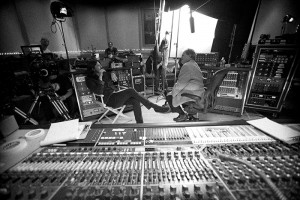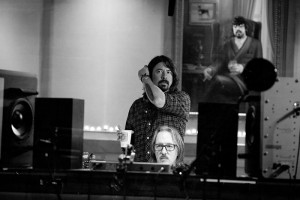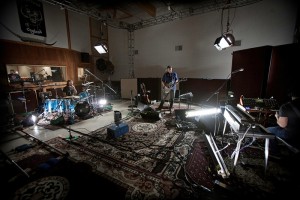Dave Grohl’s Sound City: A Music Movie Review
Towards the end of Dave Grohl’s directorial debut, the rock documentary Sound City, drummer Mick Fleetwood warns us about “the downside” to all the technological advances that have so changed the face of music production: That they might lead a person into “thinking that ‘I can do this all on my own.’”
“Yes, you can do this all on your own,” Fleetwood quickly concedes. “But you’ll be a much happier human being to do it with other human beings. And I can guarantee you that.”
Sound City is at its best whenever it takes this tone—which it does most of the time. Those of us who feared (like I did) that the film might come across as an ode to diamond-encrusted buggy whips can breathe easy.
That’s not to say that Grohl and his interview subjects (the likes of Tom Petty, Paul McCartney, Rick Rubin) don’t pine for increasingly impractical analog technologies that have been largely supplanted over the years. Or that they don’t sometimes look down their noses on the digital tools that have come to dominate music production. They certainly do both… from time to time.
But when they do, it’s largely because they’re out to promote the values that these outmoded technologies tend to reinforce: Practice, preparation, dedication, collaborative spontaneity and that in-the-moment experience of making inspiring music with inspired peers.
Despite its steadfast and somewhat conservative perspective on how music should be made, the tone of Sound City remains one of aspiration, inspiration and affection—never derision or condemnation. Even Neil Young who, now nearing his 70s, can be something of a crotchet when it comes to audio technology, is made to seem accepting of other ways of working—even as he makes curiously unstudied remarks about the birth of the CD.
His is not the only small technical lapse that may raise eyebrows among sound engineers in the know. Immediately after extolling the virtues of the amazing ambient character of Sound City’s live room and how good it is for drums, the film cuts to making a big deal out of the drum sounds on Fleetwood Mack’s 1975 release by way of example. Although it’s a damn cool sound, they are in fact, some of the deadest, driest drum tracks imaginable, and could have probably been made just about anywhere, given enough baffling.
But these questionable moments don’t detract much from the movie at all. As much as Sound City pivots around changes in technology, it never obsesses over the geeky, techy details. For the most part, that’s actually a good thing. In addition to keeping the pace light and forward-moving, it allows the film a potential to reach beyond the market of a few tens of thousands of working musicians, engineers, and recording enthusiasts.
A brief cameo by that legendary designer of recording consoles, Rupert Neve, sets the tone in that department: Director Dave Grohl hams it up for the camera, nodding and smiling as if dumbstruck while Rupert Neve talks about his namesake console, which the film centers around. Grohl’s feigned ignorance is likely to comfort lay audiences as he makes pretend that basic audio terms like “microphone amplifier” and “crosstalk” are the very height of techno-babble.
This kind of self-effacing affability is part of what makes Grohl so likeable throughout Sound City. As much as he tries to make the studio and its vintage recording console the stars of the movie, it’s the personalities of the subjects that shine through. Perhaps his own, most of all.
Grohl can be both silly and sincere, sometimes at once. He has a cadence that borders on that of the ADD-surfer dude, and he seems unpretentious and un-self-serious, displaying the kind of understated confidence that comes along with knowing that you’re really damn good at playing the drums.
You don’t have to like the Foo Fighters to like Dave Grohl. And that’s a good thing, because as much as this is a story about a studio and a way of working, it’s also a personal story for Grohl. Nirvana’s Nevermind, the album that changed his life and the lives of so many others, was recorded there. And that story is tied up with the story of Sound City.
Although Grohl likes to wax poetic about how great the Sound City Neve console sounds; about how magical their room was, and about how their way was the best way to make real records, apparently the rest of the world didn’t think so for long stretches at a time. The truth is that the crusty old studio with the carpet on the walls was on the verge of going under more than once before it finally closed for business in 2011.
It had been on the verge of bankruptcy just before the Nevermind sessions came through. And it wasn’t until after that record shot past Michael Jackson and Michael Bolton on the way to #1 that the studio was hopping again.
Grohl romanticizes that console and that space, but in reality, it was the fact that great music was recorded within its walls that put the studio on the map to begin with. After a long dark period, the fact that great music was recorded there once again is what made it a hot spot once again. None of the gear had really changed. The same exact gear was there when the studio was practically dead.
The truth is that compared to the power of a great record, a good room and a great console have almost no power at all. Sound City’s many successes and failures as a studio are clear testament to that.
Although that point may have been lost on Dave Grohl at times, he does a surprisingly good job as both director and emcee. Paul Crowder’s editing and pacing are commendable as well.
The one place where the film gets just a touch self-indulgent is toward the very end when Grohl—rather than taking on the quixotic mission of trying to save Sound City Studios—simply buys their old console for himself and installs it in what’s essentially an oversized home studio. Here, Grohl collaborates with a string of A-list rock stars, to mixed results.
Some of the pairings are more awesome in theory than they could ever be in real life, such as when Sir Paul McCartney and Nirvana bassist Krist Noveselic swing by to join Grohl in writing a new rockish romp, reminiscent of Helter Skelter, right on the spot.
A jam session with Trent Reznor of NIN and Josh Homme of Queens of the Stone Age leaves the two seeming a bit pompous compared to the down-to-earth Grohl, but the result is a downright memorable instrumental track, with a few words in defense of both digital tools and formal music training.
For me, the standout musical moment was an unexpected one: Lee Ving of the band Fear sings a bewildering punk rock tune at breakneck speed that sounds just a like a lost track from Nomeansno. Out of the entire movie, it’s probably the one song that Kurt Cobain would have really, really liked.
Even this whole section, the spottiest in the movie, is still a good watch. The only thing that really doesn’t work in the entire film is—ironically enough—the sound mix.
At times, the level fluctuations in Sound City are laughably ill-advised. I’ve never in my life found myself riding the volume control on my remote like I had to while watching this movie.
Perhaps those jarring jumps in loudness between music and dialogue were intended to be exhilarating. Maybe they even work inside of a movie theater. But seeing that the movie is playing in exactly two theaters worldwide, it’s safe to say that the majority of viewers have been watching at home, just like me. In this context, the rollercoaster levels are at times beyond awkward, even bordering on frustrating.
But these quibbles aside, Sound City is a surprisingly able debut for a new director. Regardless of whether you’re 100% sold on all of the film’s conclusions, it makes its case warmly and often, and it’s easy to recommend to any fan of rock music or recording technology.
At $7 to rent and up to $13 to download, the price is slightly higher than average, but it makes sense for a niche film like this one. Based on the overwhelmingly positive user reviews for the movie, it’s safe to say that most of the thousands of people who have ordered it so far have felt it was money well-spent.
In the end, it’s an uplifting movie, even if the moment of the studio’s shutting down strikes you like an honest tragedy. I found myself getting a little choked up as the original studio came to a close. And not just because it was so sad, but because the movie made it all seem so avoidable, as if it was merely principled stubbornness over technology and workflow that came between the studio and financial solvency.
As Sound City reached its heartbreaking nadir, my girlfriend turned to me and asked, “Why didn’t they just adapt? It seems like it would have been so much easier.” It’s a good question. And I didn’t have an answer. I still don’t.
Justin Colletti is a Brooklyn-based audio engineer, college professor, and journalist. He records and mixes all over NYC, masters at JLM, teaches at CUNY, is a regular contributor to SonicScoop, and edits the music blog Trust Me, I’m A Scientist.
Please note: When you buy products through links on this page, we may earn an affiliate commission.










junglephysicians
February 14, 2013 at 4:12 pm (12 years ago)The sound in the theatre was fantastic. No fluctuation issues.
More than two theatres, some holdovers and some upcoming: http://buy.soundcitymovie.com/theaters
Personally found all collabs pretty great, not “mixed results”.
Drew Vogelman
February 14, 2013 at 4:13 pm (12 years ago)“The truth is that compared to the power of a great record, a good room and a great console have almost no power at all.”
Actually, great players in a good room with a great console (and a few nice mics) do make a great record- and I’d hope you, as an engineer, would agree with this.
And as to your ‘girlfriend turned to me and asked, “Why didn’t they just adapt? It seems like it would have been so much easier.” It’s a good question. And I didn’t have an answer. I still don’t.’
Adapt how? By buying a computer with Pro Tools? Would that have changed everything for Sound City? I don’t think so. And I’m pretty sure I saw a bunch of Digi gear in the racks behind the Sound City assistant.
This was a film about the change in music recording culture- not music recording technology- let alone culture in general. A rather cynical culture which resonates in your review.
I knew nothing of Dave Grohl aside from him being the drummer in Nirvana & the singer/guitar player in the Foo Fighters- but I found his lack of cynicism quite refreshing.
Ross CMR
February 14, 2013 at 7:51 pm (12 years ago)Pretty excited to see this tomorrow night! cathing the 7:20 showing at the hollywood theater Portland, OR. Definitley getting the sound track too
Eagle
February 15, 2013 at 12:44 am (12 years ago)Great documentary until the part where Grohl bought the console to his studio and started recording random obvious music and pretended that they all sounded cool.
TrustMeI'mAScientist
February 15, 2013 at 8:13 am (12 years ago)Thanks for weighing in Drew.
On the first point, I think you may have missed the point. Perhaps that’s my fault. Here’s another try:
There have been many forgettable records made at Sound City. For starters, the film talks about as many as 10 other bubblegum artists the studio invested in alone (just like Rick Springfield) who failed to make music that resonated.
The truth is that it’s the great records that make that console and that room sound good, much more so than the other way around. Nevermind is what got people coming back to Sound City — Not the Neve console, which had been there for decades. Great music is rare. Great gear isn’t.
On the second point, I’d heartily agree that it’s misleading to suggest that just buying a Pro Tools rig would have saved Sound City. To my understanding, they already had one.
As written, it’s the movie that makes it *seem* as if that was the case. It seems we agree that’s a flaw. Perhaps I could have made that more clear. But much like Dave Grohl, I allowed poetic license to overtake the competing urge for clarity, accuracy, and comprehensiveness.
You’re right to say there are a lot of things that the music industry as a whole has failed to adapt to — whether it’s changes in budgets, workflows, tastes, distribution, or effectively fighting piracy in its newest forms.
The industry is finally coming around on all of that, but it has taken understanding and accepting the reality of the world as it — Not living in fantasy.
There is certainly a lot of fantasy is this film. It’s comforting, inspiring fantasy that reinforces good values, and I’m glad to have watched it. But perhaps we’d both agree that it also left a lot out. And so did my review.
cirk kobain
February 18, 2013 at 12:37 am (12 years ago)Dave Trohl and his anti digital agenda….bunch of bs
stoodioratt
March 5, 2013 at 10:55 am (12 years ago)Great review Justin. I am becoming a big fan of your writing. It was nice to to hear some of things I was thinking, while watching the film, articulated so well here.
After the movie, I was left wondering why Grohl hadnt just made his Sound City record at Sound City to help Sound City, but I think Kevin Augunas may have already bought the place.
Here is a quote from Keith Olsen (SC engineer who was behind the Neve for Rick Springfield) that sums up gear/room vs players/songs for me:
“You can have a hit record with a great song, you can have an even bigger hit record with a great performance of that great song. And you know, the very final thing is sound. And if you have a great song, that has a great performance and it’s recorded on some piece of junk recorder that barely records, you still have a hit record. But if you can put all three together, you have those giant records. Where you have song, performance and sound.”
TrustMeI'mAScientist
March 7, 2013 at 3:38 pm (12 years ago)Thanks for the kind words — and the quote.
Bryan Hume
March 9, 2013 at 12:25 am (12 years ago)I believe Sound City is one of the most important music documentaries to come by in decades. There is something inherently special about recording analog, despite how easy it may seem to switch over to digital. When you’re converting everything into numbers essentially, switching mediums is more than just changing to something more efficient – it’s moving over to something less human. So although they could’ve adapted, they wouldn’t be themselves.
Anyway, I highly recommend this movie. And listen to the sound track – it rules. Seriously.
Amanda Dissinger
March 13, 2013 at 10:45 am (12 years ago)Loved this movie! Really excited for the DVD/soundtrack
release that’s coming out too. Check out the trailer: http://smarturl.it/SCtrailer
nancy
March 13, 2013 at 3:35 pm (12 years ago)I LOVED this film. I never worked there, but it reminded me of all the Neve (AND SSL) installations I worked on in NYC studios (many of which are no longer there) in the 80’s. It brought back memories of all the great music and fun I had. I can also show my non-industry friends what I used to do for a living. Great film!